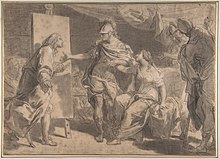

Campaspe (/kæmˈpæspiː/; Greek: Καμπάσπη, Kampaspē), or Pancaste (/pæŋˈkæstiː/; Greek: Πανκάστη, Pankastē; also Pakate), was a supposed mistress of Alexander the Great and a prominent citizen of Larissa in Thessaly. No Campaspe appears in the five major sources for the life of Alexander and the story may be apocryphal. The biographer Robin Lane Fox traces her legend back to the Roman authors Pliny (Natural History), Lucian of Samosata and Aelian's Varia Historia. Aelian surmised that she initiated the young Alexander in love.
According to tradition, she was painted by Apelles, who had the reputation in antiquity for being the greatest of painters. The episode occasioned an apocryphal exchange that was reported in Pliny's Natural History: "Seeing the beauty of the nude portrait, Alexander saw that the artist appreciated Campaspe (and loved her) more than he. And so Alexander kept the portrait, but presented Campaspe to Apelles." Fox describes this bequest as "the most generous gift of any patron and one which would remain a model for patronage and painters on through the Renaissance." Apelles also used Campaspe as a model for his most celebrated painting of Aphrodite "rising out of the sea", the iconic Venus Anadyomene, "wringing her hair, and the falling drops of water formed a transparent silver veil around her form".
Legacy
Campaspe became a generic poetical synonym for a man's mistress; The English University wit and poet John Lyly (1553–1606), who produced his comedy Campaspe in 1584, also wrote:
Cupid and my Campaspe play'd
At cards for kisses—Cupid paid:
He stakes his quiver, bow and arrows,
His mother's doves, and team of sparrows;
Loses them too; then down he throws
The coral of his lip, the rose
Growing on's cheek (but none knows how);
With these, the crystal of his brow,
And then the dimple of his chin:
All these did my Campaspe win.
At last he set her both his eyes,
She won, and Cupid blind did rise.
O Love! has she done this to thee?
What shall (alas!) become of me?
The Spanish playwright Pedro Calderón de la Barca wrote his own play on the Campaspe story, Darlo todo y no dar nada (1651).
In 1819, the painting Générosité d'Alexandre, by Jérôme-Martin Langlois depicted the scene where Alexander the Great gifted Campaspe to Apelles.
The Campaspe River in Victoria, Australia, the Campaspe River in Queensland, Australia and the Shire of Campaspe are named after her.
In E. R. Eddison's books of Zimiamvia, Campaspe is a water nymph who changes from human shape to a water-rat and back again. She is one of the attendants of Antiope, who represents Aphrodite.
References
- Her Thessalian name is sometimes reported in Atticized form as Pancaste.
- John J. Popovic, "Apelles, the greatest painter of Antiquity" Source quotes from Natural History 35.79–97.
- Fox, Alexander the Great, 1973:50.
- Peck (1898).
- "Alexander Ceding Campaspe to Apelles". www.getty.edu. Getty. Retrieved 24 January 2023.
- "The romance of Australian place names". The Australian Women's Weekly. 27 May 1964. p. 59. Retrieved 14 October 2013 – via National Library of Australia.
Sources
- Pothos.org: Alexander's lovers
- Harry Thurston Peck, Harper's Dictionary of Classical Antiquities, 1898 "Campaspe"
- John Lyly: "Cupid and my Campaspe..."
- John Lyly: A Moste Excellent Comedie of Alexander, Campaspe, and Diogenes 1584